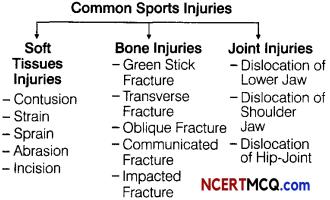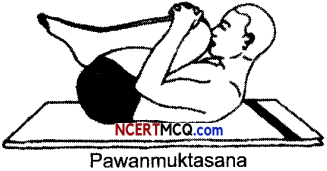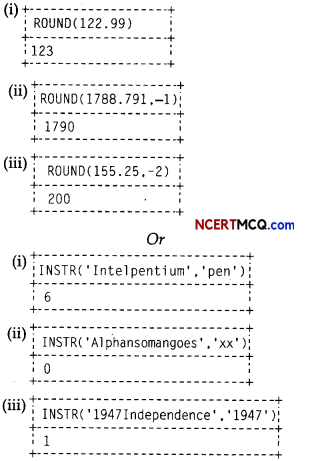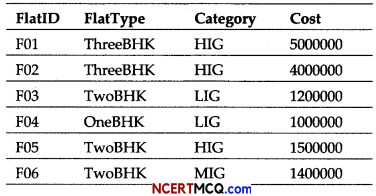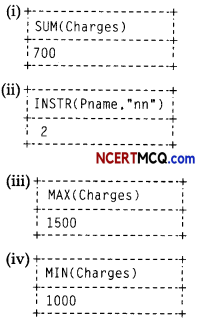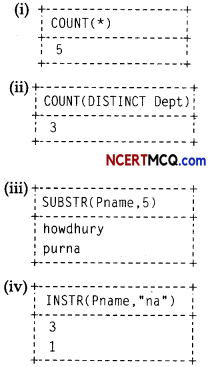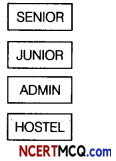Students can access the CBSE Sample Papers for Class 12 Physical with Solutions and marking scheme Term 2 Set 10 will help students in understanding the difficulty level of the exam.
CBSE Sample Papers for Class 12 Physical Education Term 2 Set 10 with Solutions
General Instructions :
- There are three sections in the Question paper namely Section A, Section B and Section C.
- Section A consists of 9 questions amongst which 7 questions have to be attempted.
Each question carries 2 marks and should have 30-50 words. - Section B consists of 5 questions amongst which 3 questions have to be attempted.
Each question carries 3 marks and should have 80-100 words. - Section C consists of 4 questions amongst which 3 questions have to be attempted.
Each question carries 4 marks and should have 100-150 words.
Maximum Marks : 35
Time : 2 Hours
![]()
Section A
Question 1.
Oppositional Defiant Disorder mostly affects teenagers, but can it affect adults? (2)
Answer:
Oppositional Defiant Disorder mostly affects children in their period of adolescence or teenagers. However, it can affect adults too. Adults with Oppositional Defiant Disorder (ODD) display a pattern of negative, hostile and defiant behavior that lasts for atleast six months. Adults with ODD are more than just aggressive and irritating from time to time.
Question 2.
Explain the step-by-step procedure of Ardha Chakrasana. (1 + 1)
Answer:
Procedure of Ardha Chakrasana is
- Stand straight and arms alongside the body.
- Balance the weight equally on both feet.
- Breath in, extend the arms overhead, palms facing each other.
- Bend backward, push the pelvis forwards, keeping the arms in line with the ears, elbows and knees straight, head up and lift the chest up towards the ceiling.
- Breathing out, bring the arms down and relax.
- Return to the normal position, repeat the exercise after five minutes.
![]()
Question 3.
What do you understand by assertive behavior? (2)
Answer:
Assertive behavior is the behavior that involves use of proper or legitimate physical or verbal force that creates pressure to achieve one’s purpose. This type of behavior is assertive, goal-directed with no specific intent to cause harm.
Indirect insults or saying something about the opponent player indirectly to cause psychological discomfort is an example of assertive behavior.
Question 4.
What is the importance of yoga in curing lifestyle diseases? (1 + 1)
Answer:
The importance of yoga in curing lifestyle diseases is
- Yoga helps to increase physical activity which reduces obesity that is the chief cause of lifestyle diseases.
- By doing the yogic asanas like Bhujangasana, Paschimottanasana and Pavanamuktasana and diabetes can be cured.
![]()
Question 5.
Explain the benefits of Shavasana. (0.5 x 4)
Answer:
The benefits of Shavasana are
- It relaxes the whole bo y.
- It releases stress, fatigue, depression and tension.
- It improves concentration and cures insomnia.
- It helps to calm the mind and improves mental health.
Question 6.
What do you understand by speed? (2)
Answer:
Speed is the rate of motion or the rate of position. It is expressed as distance moved per unit of time. Speed is defined as the ability and capacity of an individual to perform similar movements consecutively at the fastest rate. For example, short-distance races like 100 meters and 200 meters.
Question 7.
Explain the Fartlek Training Method. (2)
Answer:
Fartlek is a Swedish term which means, ‘speed play’ and has been used by distance runners for years. Fartlek is a form of road running or cross-country running in which the runner usually changes the pace significantly during the run. It is a combination of slow and fast running on different terrains, covering hills, etc. Self-discipline plays a vital role in this method of training.
![]()
Question 8.
Mention the demerits of the Continuous Training Method? (1 + 1)
Answer:
Demerits of Continuous Training Method are
- It does not improve anaerobic fitness.
- It can be hard to keep going when you start to fatigue.
Question 9.
What are the benefits of Ardha Chakrasana? (2)
Answer:
The benefits of Ardha Chakrasana are
- It stretches the front part of upper torso.
- It tones the arms and shoulder muscles.
- It helps in relieving constipation.
- It enhances flexibility of hip joints.
- It controls high blood pressure.
Section B
Question 10.
Explain the symptoms of cognitive disability. (3)
Answer:
Symptoms of cognitive disability are
- Difficulty in planning and sequencing thoughts and actions.
- Difficulty in interpreting the meaning of numbers and symbols.
- Emotional imbalances or/and emotional outbursts.
- Motor coordination not proper, poor posture or physical imbalance.
- Difficulty in learning and memorising.
![]()
Question 11.
Differentiate between minor and major sports injuries. (1 x 3)
Answer:
The differences between minor and major sports injuries are
| Minor Injuries | Major Injuries |
| These injuries are soft tissue injuries related to skin or muscles. | These are hard tissue injuries related to bones and joints. |
| These injuries do not affect much to the fitness of the player. | These injuries affect the health and fitness of the players. |
| They heal at a faster rate. | They take long time to heal. |
Question 12.
Make a comparison between open and closed fracture. (1 x 3)
Answer:
The comparison between open and closed fractures is
| Open Fracture | Closed Fracture |
| This is a kind of fracture in which the bones come out of the skin due to cuts on the skin. | This is a kind of fracture in which the broken bones remain inside the skin covering. |
| There is skin rupture and cuts by the edges of the sharp bones. | There is no open cut over the skin as bones remain inside. |
| This type of fracture is quite complicated and takes a longer time to heal. | This type of fracture takes a comparatively shorter time to heal. |
![]()
Question 13.
Explain any three causes of aggression in sports. (1 x 3)
Answer:
Three causes of aggression in sports are
- Extreme Stress Players undergo lots of stress, tensions and frustrations due to which they show aggression while playing.
- Competition Aggression can also be caused by the pressure created due to extreme competition on the field. Sportspersons face stiff competition from the other players due to their desire to excel in their sports.
- Relationships Poor relationship skills with the coach, team caption or members may also cause anger leading to aggression.
Question 14.
How isometric exercises are different from isokinetic exercises? (1 x 3)
Answer:
Isometric exercises are diferent from Isokinetic exercises in the following ways
| Isometric Exercises | Isokinetic Exercises |
| In these exercises, no visible movement is there. | In these exercises, there is a visible movement. |
| Equipment are mostly not required or they are required in less number. | Specialized equipment are required to perform these types of exercises. |
| The length of the muscles do not change in these types of exercises. | The length of the muscles changes in these exercises as there is high pressure over the muscles. |
![]()
Section C
Question 15.
What are the disability etiquettes that a society should follow for the disabled people? (0.5 x 8)
Answer:
The society should observe certain disability etiquettes for the disabled people. They are It is always important to respect the dignity of disabled people. So, talk to them with respect so that their self-esteem and confidence are built up.
- When introduced to a person with disability, it is appropriate to offer shake hands.
- Respect the individuality of the person. So, avoid generalising the disabled people and call them by their names.
- Talk to the person and address him/her directly instead of talking through a friend or an interpreter who may also be present.
- Do not touch their belongings without permission such as wheelchair, walking stick, etc.
- If you offer assistance, wait until the person responds. Then, listen carefully to his/her instructions.
- Do not speak about the disabled people as if they are invisible or cannot understand what is being said.
- Do not show extra attention or added care as it may give a feeling of sympathy.
- Treat them with the same attention and care as with normal people.
![]()
Question 16.
Mention some strategies that can be used to make physical education accessible for CWSN. (0.5 x 8)
Answer:
The strategies that can be used to make physical education accessible for CWSN are
- Provide activities according to individual abilities that are specially designed for these children.
- These children should be made to play under the observance of experts, teachers and coaches to avoid any risk or dangers.
- The rules of the games should be modified to suit the individual needs and level.
- The children should be given sufficient time for training and practice so that they gain efficiency.
- The sports equipment should be modified and designed according to the specific needs of the children.
- Normal schools should be encouraged to develop adequate infrastructure to support the activities of these children.
- Spectators or people watching the sports competition should encourage these children so that they are motivated to do even better.
- The teachers and coaches conducting the physical activities should have knowledge and understanding of the new techniques of their fields.
Question 17.
Explain the step by step procedure of (2 + 2)
(i) Shavasana
(ii) Paschimottanasana
Answer:
(i) Shavasana (Corpse Pose) is done in lying position. To do this asana, lie flat on the back, like in sleeping pose.
There should be a gap of 1 feet between the legs. Keep the arms at side and palms facing up and relax. Close the eyes and breathe deeply and slowly through the nostrils.
(ii) Paschimottanasana is done in sitting posture. To do this asana, sit on the floor with the legs stretched out. Sit straight, raise both arms above your head and stretch up. Bend forwards and hold the big toes with the middle and index fingers. Then, exhale out slowly and try to touch the knees with your forehead. Take five deep breaths.
![]()
Question 18.
Give a detailed explanation of the different methods of training to develop or improve strength. (2 + 2)
Answer:
There are two different methods of training to develop or improve strength. These are
(i) Isometric Exercises These exercises were introduced by Hettinger and Muller in 1953. The word ‘isometric’ refers to the length of the muscle that remains same during workouts. This happens when there is a tension on a muscle but no movement is made, causing the length of the muscle to remain the same.
Therefore, one cannot see any external movement but a muscle is stretched as a lot of pressure is exerted on it.
These exercises are very helpful in sports like archery, yoga, judo, weightlifting, etc. Example of these exercises are pressing or pushing a wall, lifting a very heavy weight, pulling the rope in a tug-of-war, etc.
(ii) Isotonic Exercises These exercises were developed by De Loone in 1954. The word ‘isotonic’ refers to the toning of the muscles by repetitive exercises. Here, external movement in the muscles can be seen clearly.
When tire muscles contract repeatedly, then they develop strength and endurance. The muscles or group of muscles change in size, i.e. shortens and lengthens during action. Isotonic exercises are of two types concentric and eccentric
(a) Concentric It means upward movement of the muscles like lifting dumbbells, throwing a ball, etc. It shortens the muscles as you overcome the force of a weight.
![]()
(b) Eccentric It means downward movement of the muscles like lowering the dumbbells down. It lengthens the muscles while being opposed by the force of a weight.
